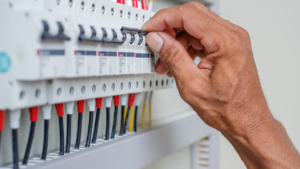
Basics of Home Circuitry
Your home’s internal wiring acts as a giant electrical circuit, controlled by your electrical panel. One set of wires (hot wires) brings electricity into your home while another (neutral wires) sends it back out into the electrical grid. Each room contains its own set of hot and neutral wires, which allow them to conduct electricity independently of one another. It’s a safety precaution, ensuring that a malfunction in one part of your home doesn’t endanger the rest of it.
Basic Electrical Capacity
Every home circuit is built with a maximal electrical capacity, which is the amount of power its wiring and service panel can safely handle. Electrical capacity is measured in volts, amps, and watts. Volts are the force that pushes electrical charges through your circuits. Electrons in high voltage circuits have lots of pressure moving them through your system. Amps are the number of electrons passing through each circuit at any given moment, similar to the flow of water through a pipe. Finally, watts are the total amount of energy produced by a generator or consumed by an electrical circuit.
Volts, amps, and watts are interconnected. When you multiply amps and volts, you get watts. When you divide watts by amps, you get volts and when you divide watts by volts, you get amps. Put simply:
- Volts x Amps = Watts
- Watts / Amps = Volts
- Watts / Volts = Amps
Every circuit in your home has a maximum wattage, limiting the amount of power it can conduct. A 20 amp, 120-volt circuit can only carry 2,400 watts. Forcing more watts through the circuit causes electrons to build up inside, like water backing up in a pipe. When you run electricity through a light bulb, electrons accumulate inside the filament because filaments have a greater electrical resistance than the wires feeding them. Increasing the amount of electricity causes the filament to glow brighter until eventually it overheats and burns up. The same thing happens when you run 3,500 watts through a 2,400 watt circuit. The electrons back up until they cause the wire to overheat, sometimes with disastrous consequences.
How a Circuit Breaker Works
Circuit breakers regulate the flow of electricity through your home, preventing excessive current from overloading your internal wiring. They’re made from insulated plastic, with two terminals that conduct electricity. There are several types of circuit breakers, each designed for specific voltage levels, current capacities, and protection requirements, but the two most commonly found in residential settings are:
- Magnetic Circuits. There are two plates inside every circuit breaker: a stationary plate and a moving plate. The stationary plate is connected to the frame, while the moving plate is connected to an arm called an actuator. As long as these plates are in contact, the circuit is complete and electricity can flow. In a magnetic circuit breaker, the actuator is controlled by a magnet charged by the current flowing through the contact plates. As long as the current remains below the circuit’s maximum load, the magnet never becomes strong enough to trip the actuator. But when the load exceeds the circuit’s maximum capacity, the magnet finally has enough energy to pull the plates apart and break the circuit.
- Soldered Circuit. Like a magnetic circuit, a soldered circuit contains two contact plates. In this case, they’re controlled by a block of alloy (solder) made from metals that expand at different temperatures. As current flows through the actuator, it heats the solder. When it reaches maximum load, the metals expand at different rates, forcing the solder to bend and turn the actuator, interrupting the circuit.
The advantage of circuit breakers is they can be reset after they trip, unlike fuses, which burn out completely. Disconnect a few appliances before resetting them, however. Otherwise the circuit’s likely to trip again. If it trips again anyway, call an electrician. You may be dealing with a short circuit, ground fault, or arc fault, which require professional assistance.
Save Money On Electrical Repairs with Agway EnergyGuardTM
Circuit breakers protect against overcurrent, a problem you’re more likely to encounter as your house ages and your wiring experiences more wear and tear. This type of damage is incremental, which makes it exempt from home insurance. Agway’s EnergyGuardTM Program, on the other hand, specifically covers you in the event of a breakdown brought about by regular use.
EnergyGuardTM covers your heating, cooling, and electrical systems.* When the need for repair occurs, our customers don’t have to waste time hunting around for a qualified repairman. They call us instead. We maintain an extensive network of skilled contractors. As soon as we receive your message, we send the first available one straight to your door. There are no service fees or deductibles either. We cover the expenses of the visit and covered parts. Don’t let a malfunction upset your household budget. Sign up and start enjoying the benefits of EnergyGuardTM today!
*Coverage depends on commodity purchased.